An Evaluation of Hofstede's Cultural Dimensions for Study Skills
VerifiedAdded on 2020/12/09
|6
|1286
|422
Essay
AI Summary
This essay examines Hofstede's cultural dimensions, providing an overview of individualism vs. collectivism, masculinity vs. femininity, and their influence on organizational behavior. The analysis evaluates Hofstede's model, suggesting the strengths of collectivism and femininity in fostering relationships and prioritizing quality of life. The essay suggests that companies seeking global expansion should adapt to diverse cultural values, embrace uncertainty avoidance, and adopt long-term orientation. The conclusion highlights the importance of understanding cultural nuances for effective business functioning, emphasizing the impact of cultural values, rituals, and beliefs on business operations and marketing strategies. The essay also includes an evaluation of the dimensions and suggests other dimensions for the theories and cultural dimensions.

Study skills for higher
education
education
Paraphrase This Document
Need a fresh take? Get an instant paraphrase of this document with our AI Paraphraser
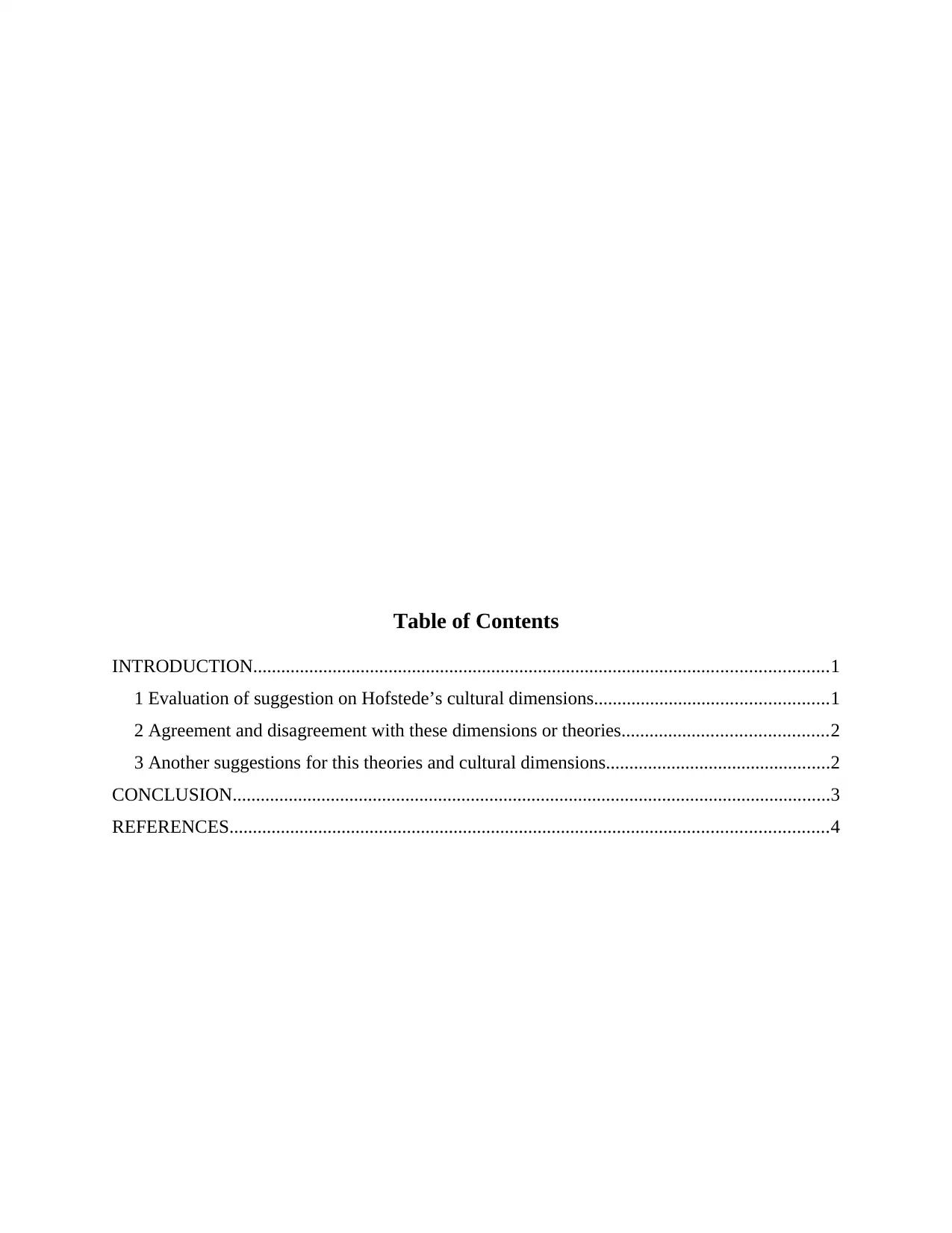
Table of Contents
INTRODUCTION...........................................................................................................................1
1 Evaluation of suggestion on Hofstede’s cultural dimensions..................................................1
2 Agreement and disagreement with these dimensions or theories............................................2
3 Another suggestions for this theories and cultural dimensions................................................2
CONCLUSION................................................................................................................................3
REFERENCES................................................................................................................................4
INTRODUCTION...........................................................................................................................1
1 Evaluation of suggestion on Hofstede’s cultural dimensions..................................................1
2 Agreement and disagreement with these dimensions or theories............................................2
3 Another suggestions for this theories and cultural dimensions................................................2
CONCLUSION................................................................................................................................3
REFERENCES................................................................................................................................4
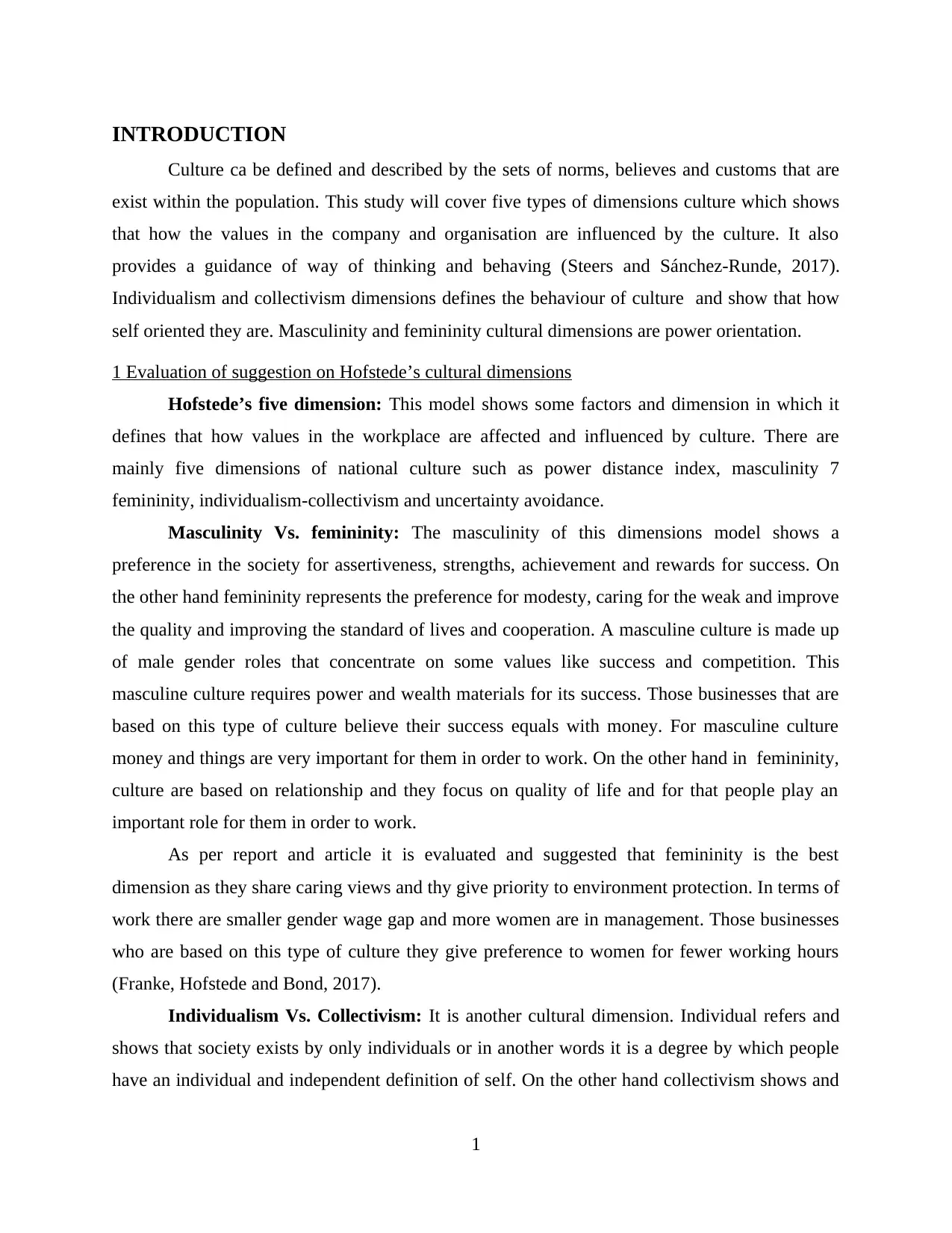
INTRODUCTION
Culture ca be defined and described by the sets of norms, believes and customs that are
exist within the population. This study will cover five types of dimensions culture which shows
that how the values in the company and organisation are influenced by the culture. It also
provides a guidance of way of thinking and behaving (Steers and Sánchez‐Runde, 2017).
Individualism and collectivism dimensions defines the behaviour of culture and show that how
self oriented they are. Masculinity and femininity cultural dimensions are power orientation.
1 Evaluation of suggestion on Hofstede’s cultural dimensions
Hofstede’s five dimension: This model shows some factors and dimension in which it
defines that how values in the workplace are affected and influenced by culture. There are
mainly five dimensions of national culture such as power distance index, masculinity 7
femininity, individualism-collectivism and uncertainty avoidance.
Masculinity Vs. femininity: The masculinity of this dimensions model shows a
preference in the society for assertiveness, strengths, achievement and rewards for success. On
the other hand femininity represents the preference for modesty, caring for the weak and improve
the quality and improving the standard of lives and cooperation. A masculine culture is made up
of male gender roles that concentrate on some values like success and competition. This
masculine culture requires power and wealth materials for its success. Those businesses that are
based on this type of culture believe their success equals with money. For masculine culture
money and things are very important for them in order to work. On the other hand in femininity,
culture are based on relationship and they focus on quality of life and for that people play an
important role for them in order to work.
As per report and article it is evaluated and suggested that femininity is the best
dimension as they share caring views and thy give priority to environment protection. In terms of
work there are smaller gender wage gap and more women are in management. Those businesses
who are based on this type of culture they give preference to women for fewer working hours
(Franke, Hofstede and Bond, 2017).
Individualism Vs. Collectivism: It is another cultural dimension. Individual refers and
shows that society exists by only individuals or in another words it is a degree by which people
have an individual and independent definition of self. On the other hand collectivism shows and
1
Culture ca be defined and described by the sets of norms, believes and customs that are
exist within the population. This study will cover five types of dimensions culture which shows
that how the values in the company and organisation are influenced by the culture. It also
provides a guidance of way of thinking and behaving (Steers and Sánchez‐Runde, 2017).
Individualism and collectivism dimensions defines the behaviour of culture and show that how
self oriented they are. Masculinity and femininity cultural dimensions are power orientation.
1 Evaluation of suggestion on Hofstede’s cultural dimensions
Hofstede’s five dimension: This model shows some factors and dimension in which it
defines that how values in the workplace are affected and influenced by culture. There are
mainly five dimensions of national culture such as power distance index, masculinity 7
femininity, individualism-collectivism and uncertainty avoidance.
Masculinity Vs. femininity: The masculinity of this dimensions model shows a
preference in the society for assertiveness, strengths, achievement and rewards for success. On
the other hand femininity represents the preference for modesty, caring for the weak and improve
the quality and improving the standard of lives and cooperation. A masculine culture is made up
of male gender roles that concentrate on some values like success and competition. This
masculine culture requires power and wealth materials for its success. Those businesses that are
based on this type of culture believe their success equals with money. For masculine culture
money and things are very important for them in order to work. On the other hand in femininity,
culture are based on relationship and they focus on quality of life and for that people play an
important role for them in order to work.
As per report and article it is evaluated and suggested that femininity is the best
dimension as they share caring views and thy give priority to environment protection. In terms of
work there are smaller gender wage gap and more women are in management. Those businesses
who are based on this type of culture they give preference to women for fewer working hours
(Franke, Hofstede and Bond, 2017).
Individualism Vs. Collectivism: It is another cultural dimension. Individual refers and
shows that society exists by only individuals or in another words it is a degree by which people
have an individual and independent definition of self. On the other hand collectivism shows and
1
⊘ This is a preview!⊘
Do you want full access?
Subscribe today to unlock all pages.

Trusted by 1+ million students worldwide
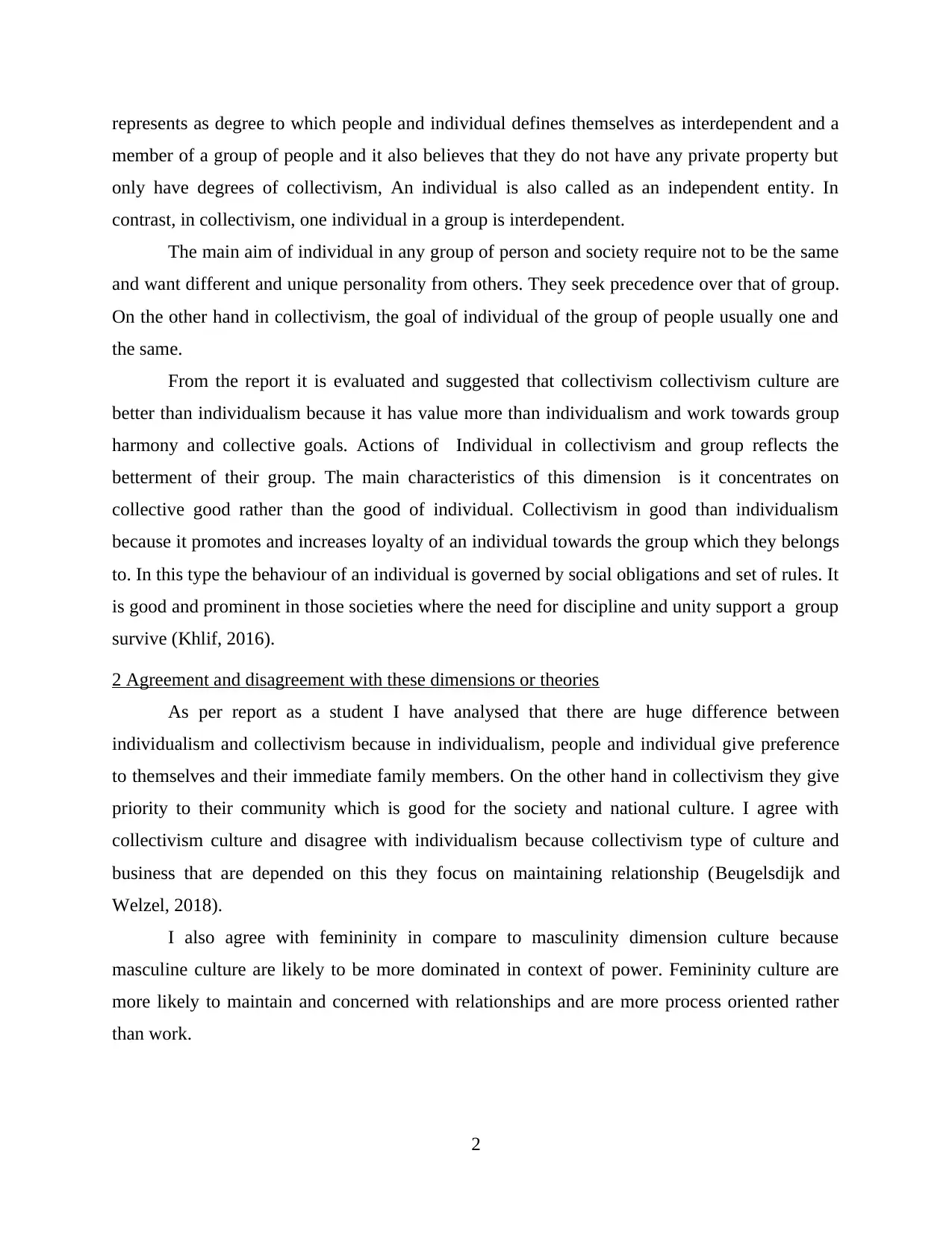
represents as degree to which people and individual defines themselves as interdependent and a
member of a group of people and it also believes that they do not have any private property but
only have degrees of collectivism, An individual is also called as an independent entity. In
contrast, in collectivism, one individual in a group is interdependent.
The main aim of individual in any group of person and society require not to be the same
and want different and unique personality from others. They seek precedence over that of group.
On the other hand in collectivism, the goal of individual of the group of people usually one and
the same.
From the report it is evaluated and suggested that collectivism collectivism culture are
better than individualism because it has value more than individualism and work towards group
harmony and collective goals. Actions of Individual in collectivism and group reflects the
betterment of their group. The main characteristics of this dimension is it concentrates on
collective good rather than the good of individual. Collectivism in good than individualism
because it promotes and increases loyalty of an individual towards the group which they belongs
to. In this type the behaviour of an individual is governed by social obligations and set of rules. It
is good and prominent in those societies where the need for discipline and unity support a group
survive (Khlif, 2016).
2 Agreement and disagreement with these dimensions or theories
As per report as a student I have analysed that there are huge difference between
individualism and collectivism because in individualism, people and individual give preference
to themselves and their immediate family members. On the other hand in collectivism they give
priority to their community which is good for the society and national culture. I agree with
collectivism culture and disagree with individualism because collectivism type of culture and
business that are depended on this they focus on maintaining relationship (Beugelsdijk and
Welzel, 2018).
I also agree with femininity in compare to masculinity dimension culture because
masculine culture are likely to be more dominated in context of power. Femininity culture are
more likely to maintain and concerned with relationships and are more process oriented rather
than work.
2
member of a group of people and it also believes that they do not have any private property but
only have degrees of collectivism, An individual is also called as an independent entity. In
contrast, in collectivism, one individual in a group is interdependent.
The main aim of individual in any group of person and society require not to be the same
and want different and unique personality from others. They seek precedence over that of group.
On the other hand in collectivism, the goal of individual of the group of people usually one and
the same.
From the report it is evaluated and suggested that collectivism collectivism culture are
better than individualism because it has value more than individualism and work towards group
harmony and collective goals. Actions of Individual in collectivism and group reflects the
betterment of their group. The main characteristics of this dimension is it concentrates on
collective good rather than the good of individual. Collectivism in good than individualism
because it promotes and increases loyalty of an individual towards the group which they belongs
to. In this type the behaviour of an individual is governed by social obligations and set of rules. It
is good and prominent in those societies where the need for discipline and unity support a group
survive (Khlif, 2016).
2 Agreement and disagreement with these dimensions or theories
As per report as a student I have analysed that there are huge difference between
individualism and collectivism because in individualism, people and individual give preference
to themselves and their immediate family members. On the other hand in collectivism they give
priority to their community which is good for the society and national culture. I agree with
collectivism culture and disagree with individualism because collectivism type of culture and
business that are depended on this they focus on maintaining relationship (Beugelsdijk and
Welzel, 2018).
I also agree with femininity in compare to masculinity dimension culture because
masculine culture are likely to be more dominated in context of power. Femininity culture are
more likely to maintain and concerned with relationships and are more process oriented rather
than work.
2
Paraphrase This Document
Need a fresh take? Get an instant paraphrase of this document with our AI Paraphraser
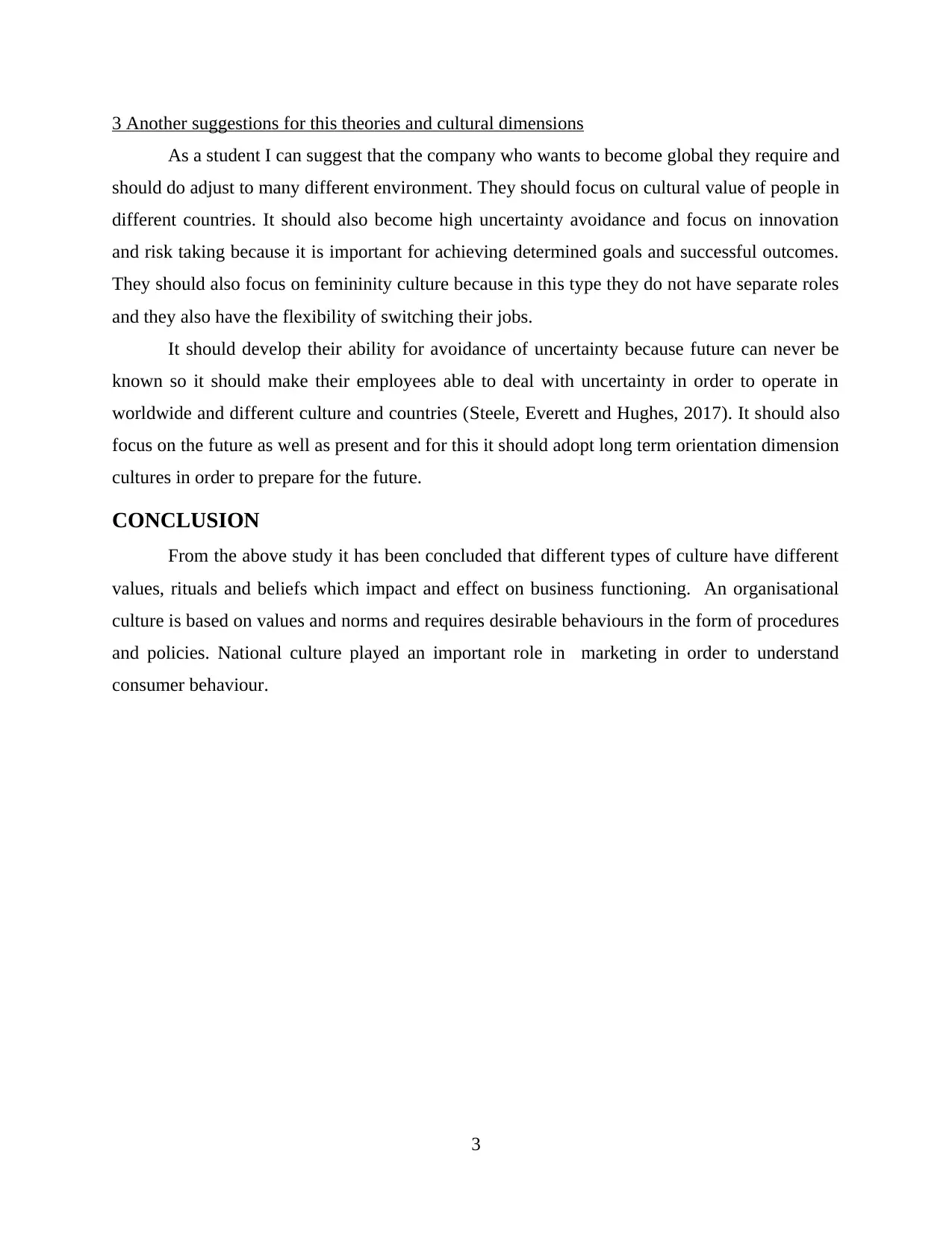
3 Another suggestions for this theories and cultural dimensions
As a student I can suggest that the company who wants to become global they require and
should do adjust to many different environment. They should focus on cultural value of people in
different countries. It should also become high uncertainty avoidance and focus on innovation
and risk taking because it is important for achieving determined goals and successful outcomes.
They should also focus on femininity culture because in this type they do not have separate roles
and they also have the flexibility of switching their jobs.
It should develop their ability for avoidance of uncertainty because future can never be
known so it should make their employees able to deal with uncertainty in order to operate in
worldwide and different culture and countries (Steele, Everett and Hughes, 2017). It should also
focus on the future as well as present and for this it should adopt long term orientation dimension
cultures in order to prepare for the future.
CONCLUSION
From the above study it has been concluded that different types of culture have different
values, rituals and beliefs which impact and effect on business functioning. An organisational
culture is based on values and norms and requires desirable behaviours in the form of procedures
and policies. National culture played an important role in marketing in order to understand
consumer behaviour.
3
As a student I can suggest that the company who wants to become global they require and
should do adjust to many different environment. They should focus on cultural value of people in
different countries. It should also become high uncertainty avoidance and focus on innovation
and risk taking because it is important for achieving determined goals and successful outcomes.
They should also focus on femininity culture because in this type they do not have separate roles
and they also have the flexibility of switching their jobs.
It should develop their ability for avoidance of uncertainty because future can never be
known so it should make their employees able to deal with uncertainty in order to operate in
worldwide and different culture and countries (Steele, Everett and Hughes, 2017). It should also
focus on the future as well as present and for this it should adopt long term orientation dimension
cultures in order to prepare for the future.
CONCLUSION
From the above study it has been concluded that different types of culture have different
values, rituals and beliefs which impact and effect on business functioning. An organisational
culture is based on values and norms and requires desirable behaviours in the form of procedures
and policies. National culture played an important role in marketing in order to understand
consumer behaviour.
3
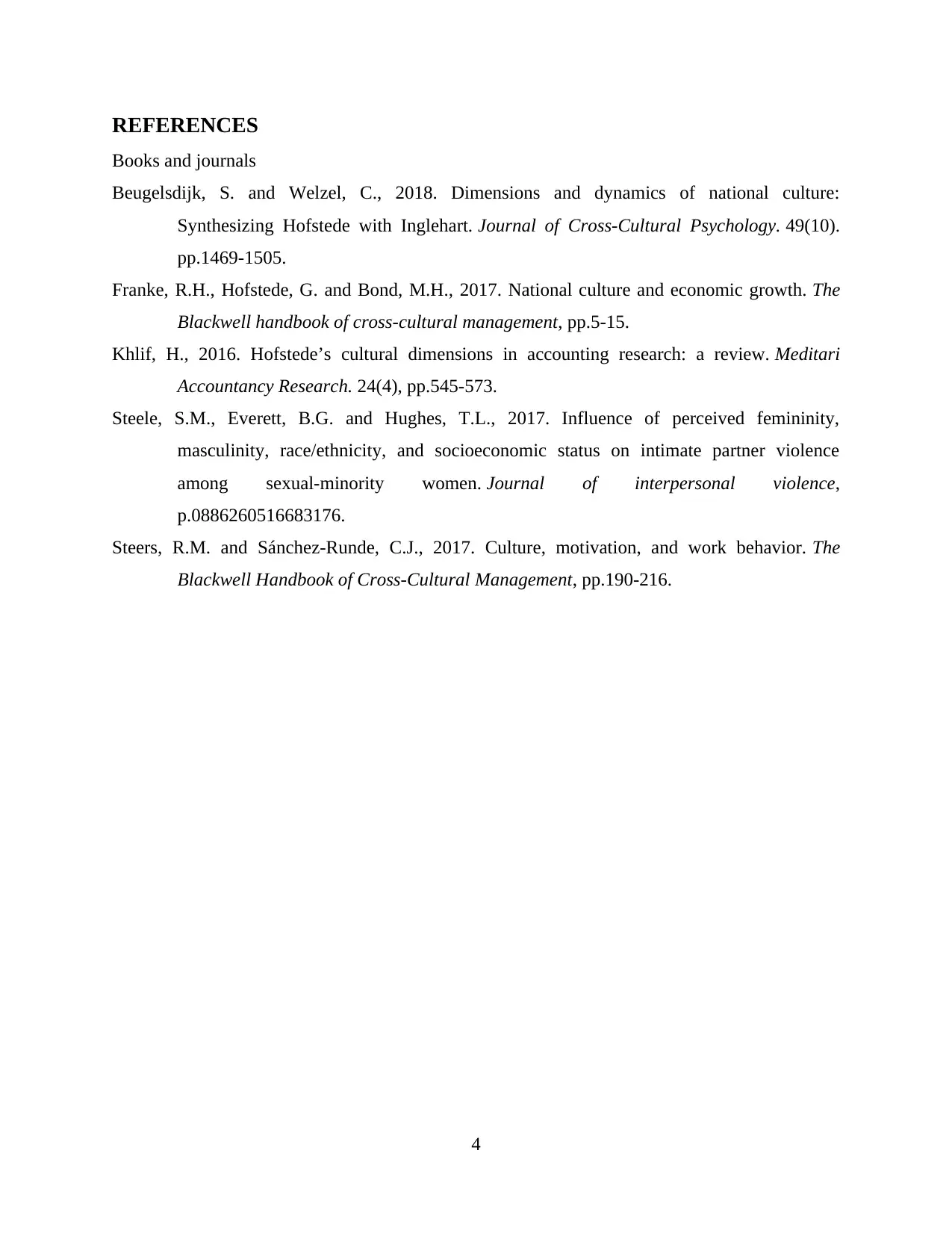
REFERENCES
Books and journals
Beugelsdijk, S. and Welzel, C., 2018. Dimensions and dynamics of national culture:
Synthesizing Hofstede with Inglehart. Journal of Cross-Cultural Psychology. 49(10).
pp.1469-1505.
Franke, R.H., Hofstede, G. and Bond, M.H., 2017. National culture and economic growth. The
Blackwell handbook of cross‐cultural management, pp.5-15.
Khlif, H., 2016. Hofstede’s cultural dimensions in accounting research: a review. Meditari
Accountancy Research. 24(4), pp.545-573.
Steele, S.M., Everett, B.G. and Hughes, T.L., 2017. Influence of perceived femininity,
masculinity, race/ethnicity, and socioeconomic status on intimate partner violence
among sexual-minority women. Journal of interpersonal violence,
p.0886260516683176.
Steers, R.M. and Sánchez‐Runde, C.J., 2017. Culture, motivation, and work behavior. The
Blackwell Handbook of Cross‐Cultural Management, pp.190-216.
4
Books and journals
Beugelsdijk, S. and Welzel, C., 2018. Dimensions and dynamics of national culture:
Synthesizing Hofstede with Inglehart. Journal of Cross-Cultural Psychology. 49(10).
pp.1469-1505.
Franke, R.H., Hofstede, G. and Bond, M.H., 2017. National culture and economic growth. The
Blackwell handbook of cross‐cultural management, pp.5-15.
Khlif, H., 2016. Hofstede’s cultural dimensions in accounting research: a review. Meditari
Accountancy Research. 24(4), pp.545-573.
Steele, S.M., Everett, B.G. and Hughes, T.L., 2017. Influence of perceived femininity,
masculinity, race/ethnicity, and socioeconomic status on intimate partner violence
among sexual-minority women. Journal of interpersonal violence,
p.0886260516683176.
Steers, R.M. and Sánchez‐Runde, C.J., 2017. Culture, motivation, and work behavior. The
Blackwell Handbook of Cross‐Cultural Management, pp.190-216.
4
⊘ This is a preview!⊘
Do you want full access?
Subscribe today to unlock all pages.

Trusted by 1+ million students worldwide
1 out of 6
Related Documents
Your All-in-One AI-Powered Toolkit for Academic Success.
+13062052269
info@desklib.com
Available 24*7 on WhatsApp / Email
![[object Object]](/_next/static/media/star-bottom.7253800d.svg)
Unlock your academic potential
Copyright © 2020–2025 A2Z Services. All Rights Reserved. Developed and managed by ZUCOL.




